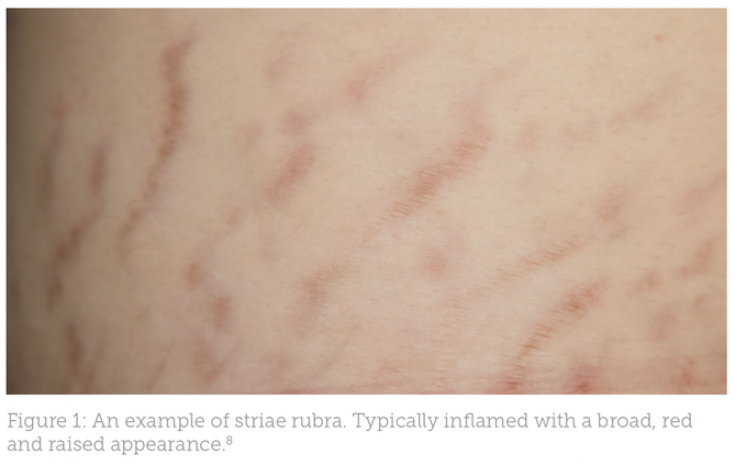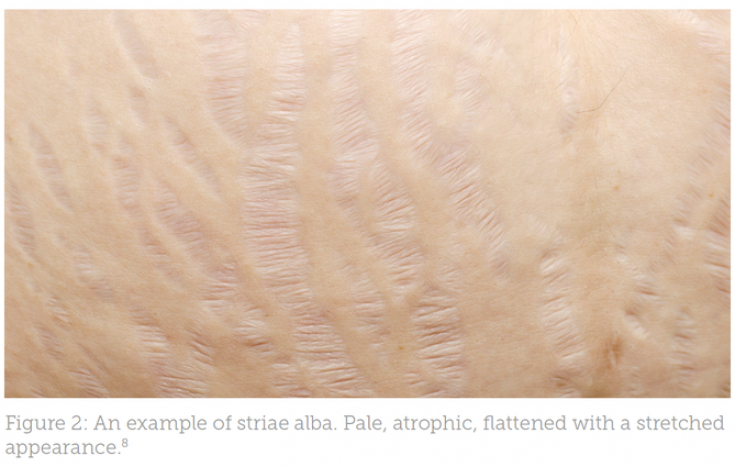About 70% of women and 40% of men worldwide experience stretch marks. Streaks – this is a defect in the skin that appears as a result of its excessive stretching.
For many people, striae become a significant aesthetic problem that negatively affects the quality of life. According to research results, in women, stretch marks most often appear in the buttocks, abdomen and thighs, and in men – buttocks, lower back and knees.
The pathogenesis of striae remains undetermined, but it is assumed that the main triggers for the formation of stretch marks are the deformation and rupture of the collagen matrix and dermis. In this article, Dr. Kieron Cooney reviews available treatments for stretch marks and evaluates their effectiveness.
Causes and classification of stretch marks on the skin
The histologies of striae and post-traumatic scars are similar: for example, in both cases, signs of early inflammatory changes are observed, followed by thinning and flattening of the dermis.
Follow us on Instagram
Atrophic changes lead to the appearance of furrows, as well as flattening of the epidermal ridges, loss of collagen and elastin. Microscopic analysis demonstrates a violation of the structure of the connective tissue of the dermis, followed by a deterioration in its mechanical function. Such changes may be due to the impact on the dermis of deforming forces that may arise as a result of the influence of various factors, including the growth of adipose tissue and intra-abdominal pressure during rapid weight gain, for example, during pregnancy.
Risk Factors:
• genetic predisposition;
• pregnancy;
• obesity;
• Cushing's syndrome;
• Marfan syndrome.
Theories explaining the occurrence of the above changes include:
• release of tissue-damaging toxins;
• changes in the collagen matrix;
• genetic predisposition;
• a sharp increase in the volume of certain parts of the body;
• elastosis due to degranulation of mast cells and stimulation of macrophages.

Fig. 1: red striae
Fig. 2: white lines
There are two types of stretch marks on the skin:
• red striae (immature stretch marks with inflammatory, erythematous changes);
• white striae (mature stretch marks, which are formed as a result of the transformation of red striae and are pale atrophic avascular formations).
Stretch marks on the skin: practical experience in the treatment of a defect at its different stages
Topical preparations for the treatment of stretch marks on the skin
There are various creams designed to prevent and treat stretch marks. Creams containing coconut oil, olive oil, wheat germ and other natural ingredients that purportedly help treat stretch marks do not actually have a sufficient evidence base for effectiveness.
Tretinoin – a form of vitamin A that is used to smooth wrinkles, fight photodamage and skin aging, has also been shown to be somewhat effective in treating stretch marks, particularly in the early stages of the disease. A randomized controlled trial showed that 0.1% tretinoin cream also reduced the appearance of red stretch marks on the abdomen after pregnancy when used daily for 3 months.
Creams containing coconut oil, olive oil, wheat germ and other natural ingredients that are supposed to help treat stretch marks do not actually have a sufficient evidence base for effectiveness.
Treatment of white and red striae: the possibilities of laser and radiofrequency therapy
Laser therapy is a popular and effective method of eliminating various aesthetic and dermatological skin problems, as well as treating white and red stretch marks. In particular, devices whose target chromophore is hemoglobin present in the dilated blood vessels of red stretch marks are effective.
Damage to the epithelium, followed by re-epithelialization, as well as stimulation of the synthesis of extracellular collagen and elastin, provides tissue remodeling and smoothing of the skin surface.
Lasers targeting water in the skin as a chromophore (10600nm ablative CO2 laser and 2940nm yttrium aluminum garnet laser) are widely used in the treatment of post-acne.
Such devices are also used for the treatment of stretch marks, especially white ones, whose histology is similar to that of post-acne scars.
Laser treatment of cicatricial skin deformities
Some studies also demonstrate the effectiveness of RF therapy in the treatment of stretch marks on the skin, which are subjected to thermal damage during the procedure. As a result, the process of wound healing, dermal remodeling and the synthesis of new collagen, elastin and hyaluronic acid are stimulated.
Stretch marks treatment with microdermabrasion, peels, mesotherapy and PRP
The following may also be considered as a treatment for stretch marks on the skin:
1. Microdermabrasion
The effectiveness of this method in the treatment of stretch marks has not been proven, however, the processes of re-epithelialization and collagen synthesis, which are triggered as a result of superficial trauma to the skin, can lead to a decrease in the severity of immature stretch marks.
2. Chemical peels, in particular, glycolic, salicylic and trichloroacetic acids at a concentration of less than 30%
However, more promising is the combined therapy with the use of peels (TCA, salicylic acid), tretinoin, microdermabrasion and mesotherapy for the treatment of red stretch marks.
3. Mesotherapy
The positive results of mesotherapy for the treatment of red stretch marks were obtained in a study involving 30 women: the severity of stretch marks decreased after 3 sessions of mesotherapy, which were carried out with an interval of 6 weeks. However, mesotherapy is more effective in combination with other therapeutic methods such as peels, radiofrequency, light therapy and PRP.
Mesotherapy is often used in combination with other procedures such as PRP therapy to improve the effectiveness of transdermal delivery of chemicals.
4. PRP
Platelets contain a variety of growth factors that modulate cell proliferation, angiogenesis and inflammatory responses, collagen synthesis, and tissue regeneration.
There are several studies on the treatment of stretch marks on the skin with platelet-rich plasma, which have shown improvement when exposed to white and red stretch marks. However, the results of therapy were evaluated subjectively by doctors and patients, so their reliability is questionable.
Thus, the most effective non-surgical method of treating stretch marks, according to available research, today can be called laser therapy. Also promising are the results of topical tretinoin cream and combination therapies such as PRP, radiofrequency, mesotherapy and microdermabrasion.
Adapted from Aesthetics







Add a comment